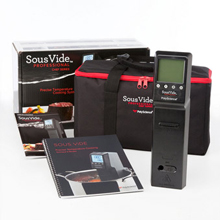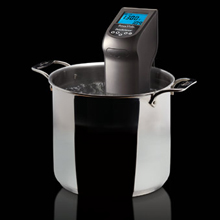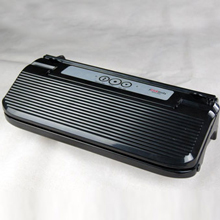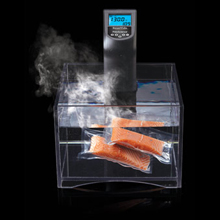Sous Vide Cooking
 Sous vide cooking is used by the world's best chefs to achieve amazing flavor and texture. Sous Vide is a cooking technique that relies on a precise, temperature controlled circulator. Food is vacuum sealed and cooked at a gentle temperature in a precisely controlled water bath.
Sous vide cooking is used by the world's best chefs to achieve amazing flavor and texture. Sous Vide is a cooking technique that relies on a precise, temperature controlled circulator. Food is vacuum sealed and cooked at a gentle temperature in a precisely controlled water bath.
Achieve perfect, repeatable results every time. ideal for delicate foods such as lobster or fish. Sous vide cooking is great for retaining vibrant flavor and texture in vegetables, and long cook times on secondary cuts of meat without drying them out.
The Sous Vide Professional offers a new dimension in control for your kitchen:
- Exact doneness for delicate foods
- Moist and tender texture
- Enhanced flavor
- Perfect results that are easy to repeat
Food Safety
As with anything in the kitchen, safe food handling procedures are required when sealing and cooking food sous vide. Sous vide safety issues are not complicated, but they're very important to understand and respect.
Click for more information
Basic rules that apply to sous vide:
SEALING- Vacuum sealing food DOES NOT make it impervious to bacterial growth; in fact, under certain conditions some bacteria actually thrive in the anaerobic (oxygen-free) environment created by vacuum sealing.
- Food to be cooked sous vide must be cold when its sealed and then either cooked immediately or stored in the refrigerator until ready to cook.
- Always use high-quality ingredients from a reputable source. Food must always be refrigerated at safe temperatures and should, when possible, be seared before sealing to eliminate surface bacteria.
- After food is cooked sous vide, it must either be served immediately or quickly and thoroughly chilled in an ice bath within four hours of entering its danger-zone temperature and then held very cold.
- If you're not going to use food within 3 days, freeze it.
History
While sous vide is a relatively new form of cooking, the fundamentals of sous vide cooking are ancient. Most cultures have traditional dishes in which the food is tightly wrapped and cooked at a low temperature for a long time.
The modern era of sous vide began in the early 1970s when food researchers and chefs in France searched for a way to reduce product loss when cooking foie gras. They found that by cooking foie gras sous vide, much higher yield and improved texture could be achieved. Since then, chefs have been inspired to step back and thoroughly re-evaluate at which time and temperature to handle ingredients while preserving maximum of its integrity, flavor and color.
Today sous vide has become standard in top kitchens worldwide. Food lovers have long admired the amazing flavors and textures that gourmet chefs achieved with sous vide cooking. With equipment and education being now more accessible for home chefs, the idea of guaranteed perfect and repeatable results with very easy steps has made sous vide extremely attractive for home chefs as well. It will add a new dimension to cooking for many aspiring chefs.
FAQ
- What are the basic steps of sous vide cooking?
Set up Sous Vide Professional with water bath and heat to desired temperature.
Vacuum seal chilled and seasoned food.
Cook food for the required time.
Sear food (if required)
Serve food or chill rapidly in ice bath or freezer if made for storing - What kinds of food is best for sous vide cooking?
Any food that benefits from precise, low temperature cooking!
Prime cuts of meat (e.g. beef tenderloin)
Secondary cuts of meat (e.g. brisket)
Delicate shellfish (e.g. lobster)
Fish filets (e.g. salmon)
Root and bulb vegetables, artichokes, squash
Eggs
Cream bases like crème anglaise
Sauce hollandaise - What equipment is needed for sous vide cooking?
Vacuum Sealer, Chamber Vacuum Sealer (Preferred)
Sous Vide Professional Thermal Circulator
Food grade plastic bags (approved for cooking)
Stock Pot or any container - What temperature and time is used for sous vide cooking?
Just below simmering water. The highest temperature is for vegetables at 185°F (85°C). Proteins are typically cooked in a range from 138°F (59°C) and 160°F (72°C).






